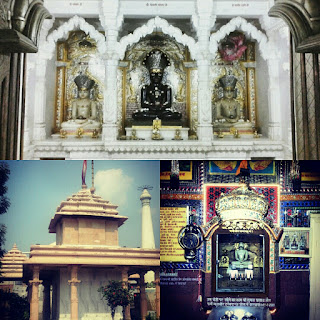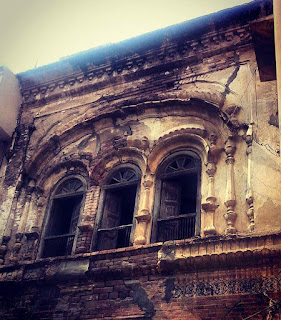SA Travel Diaries: The Jain Temples of Zira and Lehra, Ferozepur by Shriya Gautam
 |
Top: The Svetambara Temple at Zira,
Bottom Left:The Newly Renovated Svetamabar Temple, Lehra
Bottom Right: The Digambara Temple, Zira
|
Now, there were conflicting opinions on the temple and how old it was. Also, there's very limited record of it anywhere so, it was nothing short of surprising that I found out about it at all.
Sitting at the dinner table, I wondered out loud that if it was indeed 1200 years old, it would be an ancient temple, very very significant for SA and me because that would place it between circa 800-1000AD.
We drove to Zira with the music playing and the sky a beautiful blue in front of us. Zira is about 35 kms away from Ferozepur Cantonment and was a disputed territory during the Partition of 1947. On reaching, I was surprised that it was disputed at all. It's a small congested town, with mad traffic, close set houses, shops and a constricting sort of quality about it.
None of this bothered me at first because we had to do a lot of enquiring about the exact location of the temples until we met with an old gentleman, who kindly agreed to accompany us to the temple.Mr Surinder, the old gentleman, was a repository of knowledge, a kind and hospitable person, a retired teacher.
 |
| The Old Part of the Svetambara Temple, Zira |
The temple was a Svetambar temple.Mr Surinder disappeared for a bit and returned with a short, stocky middle aged woman, a Mrs Komal Jain, who had the keys to the temple. Once inside, I lost all sense of who I was with, where I came from or what they were talking of. I was this archaeologist, muttering continuosly, crazily to myself as I took pictures and interrupting Mrs Jain repeatedly with questions:
How old was this temple?
The architecture suggests late medieval to early modern?
125 years old you say? Who built it?
Acharya Atma Nand? Was he born here?
At Lehra? Is it far?
Tell me about those pilgrimage sites?
Tell me about the Siddhachakra painting? How old is it?
 |
| Original Siddhachakra Painting from 19th century |
Lucky for me, she answered them all more than happily. Mr Surinder added that once upon a time, on Diwali, all people of Zira came to the temple to pray. That reminded me that I wasn't there just to take pictures, that courtesy and protocol suggested I bow down before the idol of Mahavira adorned with Angas, put some money in the Dan patra and move on.
I also couldn't help thinking about a close freind, who is also a Jain, as I saw the demigods lying around. There was a certain, elephant headed God , similar in every way to Hindu Deity Lord Ganesh, except for the missing ladoos, mouse and the broken tusk. This one had none of those features and he was called Parshav Yaksh. There was also the Jain equivalent of Lakshmi, a Devi Padmavati; of Vishnu, a Lord Kshetrapal and a Hanuman equivalent. The similarities in iconography and motifs of these idols with that of the Hinduism was uncanny.
This reminded me that ten years ago, I had asked my friend, who the Jains prayed to on Diwali. In his ignorance that probably persists even today, much like mine until now, he had said, "Lakshmi and Ganesh!"not knowing that they prayed to Padmavati and Parshav Yaksh instead who looked the same but had different origins altogether.
The temple was a treat and soon after, we were offered a chance to go see the Digambara Temple.
"There's a Digamber Temple in Zira too?" I asked Mr Surinder,
 |
| Entrance to the Digambara Temple, Zira |
"Yes, nearby. Do you want to see?"
Of course I did! When would I ever get a chance to be in Zira again, after all? More diagonal alleys (Ms Rowling should see this!) Lots of two wheelers zooming by threateningly. We stopped by a small shop for sweetened Lassi, which Mr Surinder treated us to. And then we were there!
Mr Surinder retrieved the key from a huge house nearby and we went inside the temple with an intricately carved entrance. The interiors, however, were much simpler.
This temple was relatively newer, built in 1923. There were no demi-gods, just the Tirthankaras and one single marble statuette of Mahavira, unadorned and naked but the walls and the ceiling was richly decorated with cut glass.
A dark stocky man, a certain Mr Jain was the Keeper of Keys for the temple and he came in and informed us all about the temple. He also told me that someone from Zira, a professor in Panjab University, had written a book on the history of Zira, the only written source about the place.
 |
| Mr Jain and Mr Surinder pose for my camera at the Digamber Temple |
We went about and asked around for the book from a huge grocery shop, also owned by a Jain. This man was just as courteous as the others in the town.
What's with the people of Zira? I wondered as the man insisted we have lunch with him, which we politely declined over and over again. They are probably the most hospitable people in the whole world! They are warm, they bend over backwards to help you, and they have that calming, cleansing effect on your soul that makes you feel blessed, happy, optimistic and restores your faith in humans!
Anyway, this man here, told us that he will do everything in his power to retrieve the book, that about 50 copies were published and distributed to the townsmen, but most disposed of theirs. That's the sad fate of history in India! In Lewes or Barcombe, this book would have been all over the bookshop windows, in coffee shops, in pubs and even the smallest of shops of grocery and daily needs. Here, in India, not a copy survives because it has been disposed of!
Nonetheless, we left Zira with buoyant spirits and cheerful hearts on meeting such wonderful people! Our next stop, was a village called Lehra, about 2.5 kms from Zira, which was the birth place of Swami Atma Nand, the founder of the temple at Zira and a Svetambara Jain Guru.
There wasn't just a temple at Lehra but a grand hostel for people to stay. You could host a bloody wedding there! They have everything. You cannot take shoes inside the mess, the temple is a delight and has cut glass all over the roof, and the Bihari person who showed us around was pre informed of our visit by the grocer in Zira. We took pictures, we had tea, freshened up and then went away for the second half of our journey:to Hussainiwala Border, where more history lay buried for us, waiting to be uncovered.



Shriya, I think you just ended the post, a bit, abruptly.
ReplyDeleteThe writing style and the way you described the whole experience left me wanting more.
Nicely done and looking forward to read more.
- Meghav
We have the second half coming up, hence the abrupt end. Stay tuned for more! :)
ReplyDelete